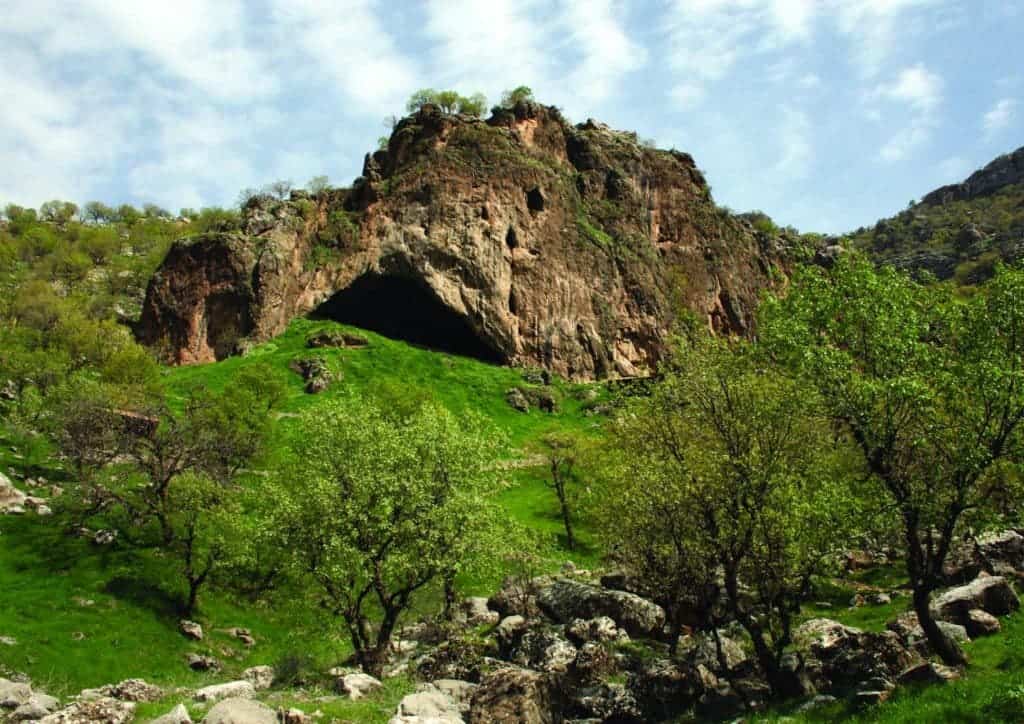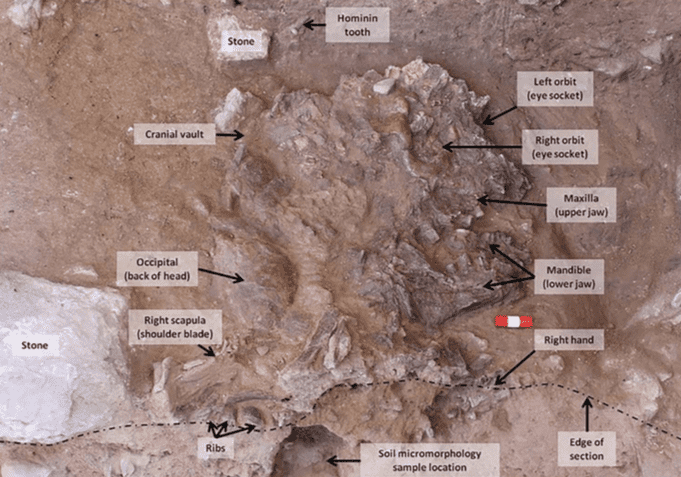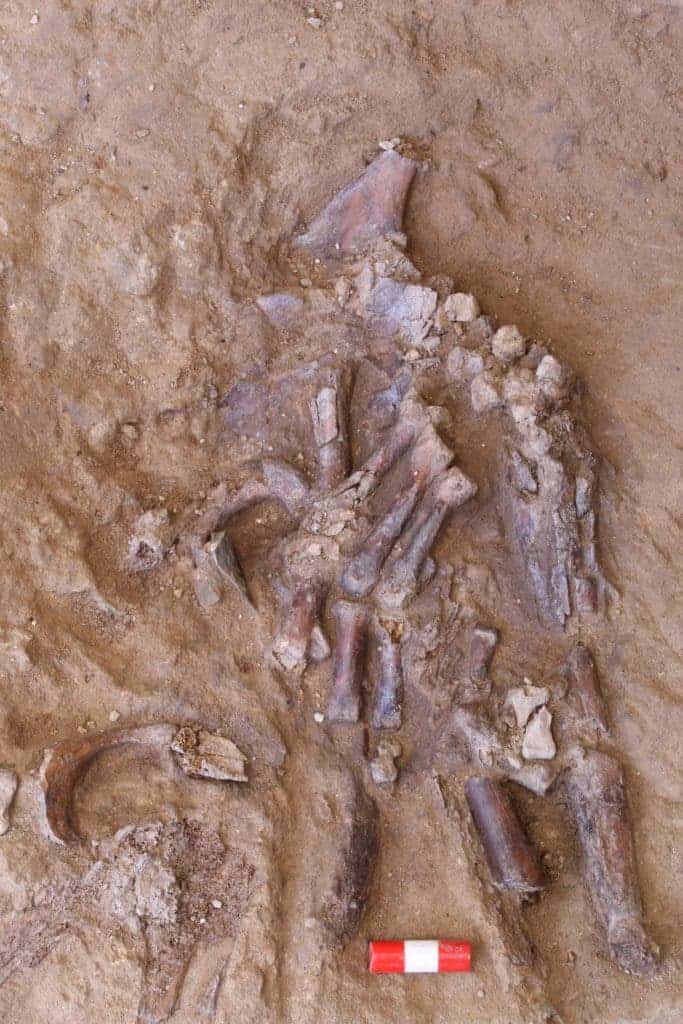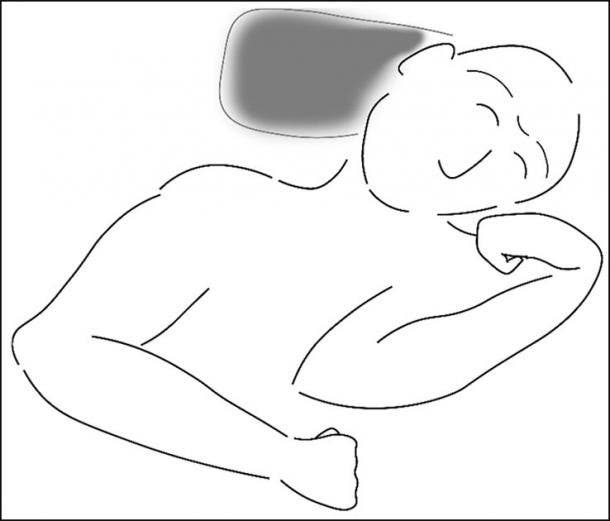Scientists have recently described the first articulated Neanderthal skeleton to come out of the ground in over two decades. The fossils were unearthed from one of the most important archaeological sites of the 20th century: Shanidar cave, in the foothills of a Kurdistan area of northern Iraq. The authors believe that the new findings could provide valuable insight into the mortuary practices of our extinct cousins.
Shanidar cave and the Neanderthal ‘flower burial’

In the 1950s, archaeologist Ralph Solecki, along with colleagues at Columbia University and Kurdish workers, unearthed the fossilized bones of eight adult and two infant Neanderthals at a site known as the Shanidar cave, in the Kurdistan area of northern Iraq. This discovery changed our understanding of Neanderthals forever
Prior to Shanidar, it was generally thought that Neanderthals more closely resembled apes — with stooped posture and bent knees — rather than modern humans.
However, Solecki’s work on the Shanidar skeletons, which looked at burials from 65,000 to 35,000 years ago, suggested that Neanderthals walked upright and employed sophisticated cultural practices. For instance, pollen found in one of the graves indicated that flowers had been buried alongside the Neanderthal dead, a practice that until then had been thought to be exclusive to Homo sapiens.
“Someone in the last Ice Age,” Solecki wrote, “must have ranged the mountainside in the mournful task of collecting flowers for the dead.”
“It seems logical to us today that pretty things like flowers should be placed with the cherished dead, but to find flowers in a Neanderthal burial that took place about 60,000 years ago is another matter,” he added.
The rare discovery ushered in a new way of thinking about Neanderthals — but not everyone was convinced. Some questioned whether the pollen was part of a flower offering, while others were skeptical of the fact that Neanderthals even buried their dead in the first place. But, the only way to settle these kinds of debates is with evidence.

More than 50 years after the initial Shanidar discovery, researchers have returned to the cave and reopened the trench where the first Neanderthal skeletons were found.
The first digs began in 2014, but stopped only two days later because ISIS was getting dangerously close to the archeological site. Exvacations resumed in the following year.

In 2016, researchers at the University of Cambridge’s Department of Archaeology found a rib emerging from the wall of the deepest part of the Shanidar trench. A lumbar vertebra and the bones of a clenched right hand soon followed. Excavations in 2018 and 2019 led to the unearthing of a complete skull and the upper body bones almost to the waist — the left hand was curled under the head like a small cushion.

“It was so exciting to see this emerge, and quite touching to see the hand – it gives you a sense of being close to someone who was so separate in time and space, and even a different species some might say, and yet at the same time very like us,” Dr. Emma Pomeroy, from Cambridge’s Department of Archaeology and lead author of the new study, told ZME Science in an email.
“We hadn’t been able to tell it [the skull] was there when we first saw the remains in the trench wall, and it took some time to excavate all the layers above so that we could reveal the remains in plan. The edge of the right eye socket was the first part to be exposed, and immediately I knew it was part of the skull, meaning there was much more to this individual than we had originally seen from what was sticking out of the trench wall. It was unbelievably exciting – I never imagined I would work on anything like this! Even the first time seeing the cave was a memorable moment for me. I had read and heard so much about it as a student and never dreamed I would get to visit it, let alone excavate Neanderthal remains there!”

Flowers for Neanderthals
Unfortunately, Solecki died last year at the venerable age of 101. Although he offered all his support and blessings, Solecki had never managed to conduct further excavations himself at the famous site.
In a new study published in the journal Antiquity, researchers have described the new Neanderthal skeleton, which might offer additional insights into the extinct hominin’s burial practices in the future.
“This skeleton is directly adjacent to where Ralph Solecki’s famous Shanidar 4 ‘flower burial’ was found, and indeed it seems that the lower part of the body of the new Neanderthal was removed when Shanidar 4’s skeleton was recovered in a block of sediment by Solecki’s team in 1960, since they didn’t realise this new individual was there. At the time, they also didn’t realise the extent of the remains they had cut through, and they never had the opportunity to return to the site and re-investigate what they left behind,” Pomeroy told ZME Science in an e-mail.
“This find is incredibly important and exciting for a number of reasons. It’s rare that such complete, articulated (i.e. with bones in correct anatomical connection) Neanderthal skeletal remains are found – this is the first to our knowledge in 25 years,” she added.
The Neanderthal skeleton, dubbed Shanidar Z, is now being investigated in labs at Cambridge, under a loan from the Kurdish Regional Government. Researchers are currently scanning the skeleton encased in sediment thousands of years old in order to generate a digital reconstruction.
Researchers are also studying the sediment samples, whose dating suggests that Shanidar Z is over 70,000 years old, looking for signs of climate change in the shells and bones of ancient mice and snails trapped in the same layer as the Neanderthal skeleton. Traces of pollen and charcoal would be particularly interesting to find as these could offer more insights into the Neanderthal “flower burial”. Shanidar Z’s sex could not be determined.
“There are long-standing debates about how Neanderthals treated their dead and we will be able to significantly contribute to our knowledge of such behaviour by looking at the microscopic structure of the sediments to find evidence for whether the depression in which the individual was found was natural or intentionally dug; whether the body was quickly covered in soil or left exposed for a period of time; and whether plants (leaves, flowers, pollen) were included with the body. All this will give us valuable new information about how Neanderthals treated their dead, and clues as to what their attitudes to the dead may have been,” Pomeroy said.
“Our evidence strongly indicates that the remains were placed in an intentionally dug depression or scoop (probably that enhanced a natural channel or depression), and was filled relatively quickly with a distinct sediment from that in the layers underneath. We also have evidence that ancient plant remains are contained within the sediments around the bones, which is exciting as this has relevance for re-evaluating the possibility that plants (leaves or flowers) were placed with the body, or perhaps used to cover it over, and of course has relevance for re-evaluating the famous ‘flower burial’ that was found right next to Shanidar Z. It will also add important evidence to our understanding of how Neanderthal treatment of the dead varied over time and space, and whether this may have had a symbolic or ritual component, rather than being purely practical in nature.”
The original excavations of the ten Neanderthal partial skeletons from Shanidar cave during the 1960s suggested that multiple individuals had been buried together in graves, alongside flowers and plant material. However, precisely where the individuals lay in relation with each other, as well as the significance of the controversial pollen grains (which some say could be modern contamination), have been the subjects of heated debates among scholars.
However, the new findings help cement the notion that Neanderthals truly employed organized and cultural practices when depositing their dead. For instance, these recent excavations have revealed that some of the bodies had been laid in a channel in the cave’s floor initially carved by water but later intentionally dug to make it deeper.
“We have been able to provide evidence that a scoop was dug in which to place the new individual, and that there are ancient plant remains in the sediments around the bones. Further analyses will enable us to tell whether the plant remains are only found with the bones, suggesting some kind of special use of plants, or whether they are more common elsewhere in the cave,” Pomeroy said.
“We also have the possibility that stones were used to mark where the bodies were, and for Neanderthals returning multiple times to deposit their dead in the exact same spot. All this evidence will contribute to our understanding of the detail and complexity of Neanderthal treatment of the dead, what such behaviour might tell us about their cognitive abilities and understanding of the landscape, and how treatment of the dead may have varied across space and time (perhaps indicating different cultural traditions, another very human trait).”
In the future, the researchers plan on continuing conserving and digitally reconstructing all of the fossils they retrieved from Kurdistan. The ultimate goal, however, is to extract ancient DNA from the bones retrieved from a region where interbreeding very likely took place with modern humans wandering out of Africa. Meanwhile, excavations at the site will continue as long as funding permits.
These findings join a number of recent studies that suggest Neanderthals weren’t mindless brutes, as some believed when the species was first being described, but rather sophisticated and resourceful people. For instance, Spanish researchers found that Neanderthals fashioned necklaces out of eagle talons and created spectacular red or black cave paintings depicting animals, dots and geometric signs, as well as hand stencils, handprints, and engravings.
“What’s exciting is that it’s rare to find articulated Neanderthal remains in the ground, so this is a very uncommon opportunity to use all the modern scientific techniques we have to understand behaviour as fully as possible. Many debates around Neanderthal mortuary behaviour, and whether it was ritual or symbolic, rely on older excavations from a time when methods and knowledge were different from today. And so there is a limit to how confident our interpretations of this older evidence can be as some information we may want today was just not available or recorded,” Pomeroy said.
“What this work gets to the heart of is how and when we became human. Ritual treatment of the dead can indicate feelings of loss, compassion for the dead, and perhaps a more spiritual understanding of the world like that we see across many human cultures, but discovering the origins of these behaviours is quite elusive. But new evidence such as the data from Shanidar Cave can help us get closer to understanding these big questions.”


